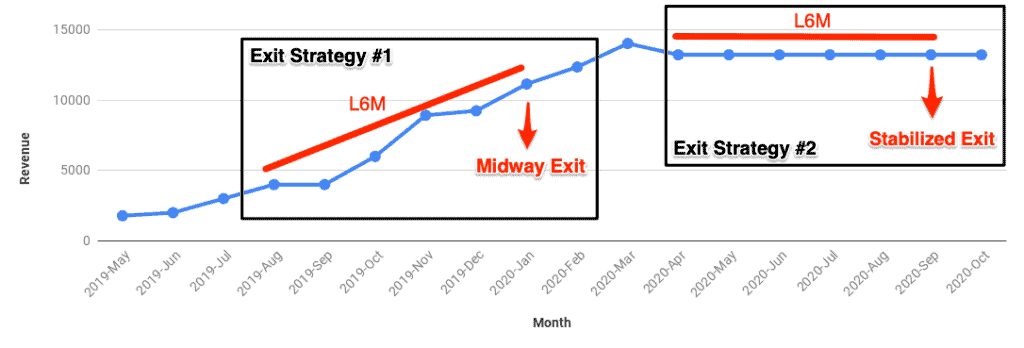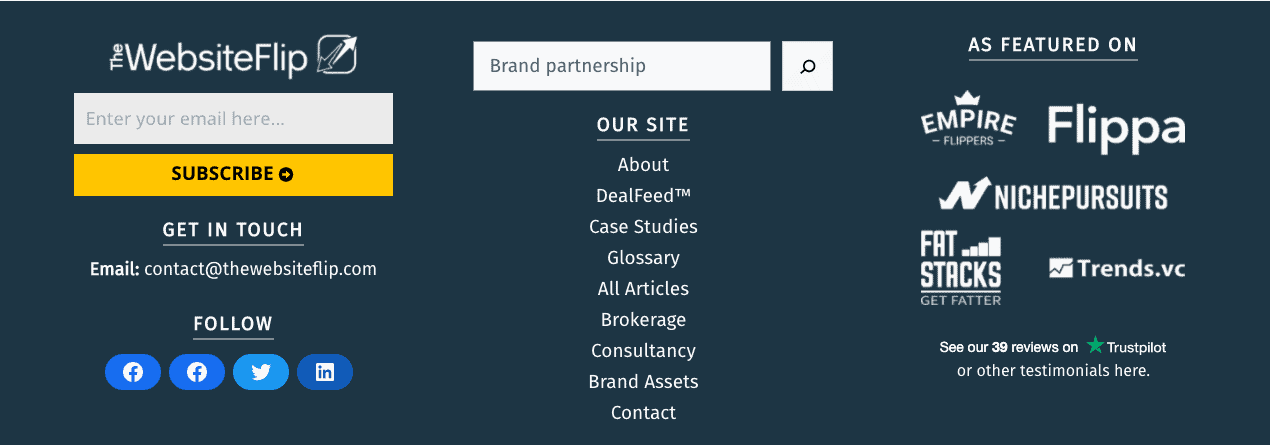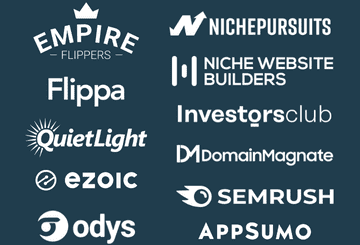Month 7 to 12 of owning a website that you purchased is part of the exit optimization phase within the website flipping lifecycle.
During this phase, you are essentially taking everything from the earlier parts of the cycle, optimizing it, fine-tuning it, and then preparing the site for a proper exit.
Here is what I cover:
- Summary of Month 1 to 6 of ownership
- Exit strategies
- 2 SEO tasks
- 2 revenue tasks
- 3 foundational tasks
Make sure to read up on the previous phases:
- Month 1 (stabilization)
- Month 2 to 6 (growth)
Let’s get into it!
Summary: Month 1 to Month 6 (Stabilization to Growth)
Months 1 through 6 of the website flipping lifecycle are all about acquiring a high-potential site, building the foundation for success, and claiming as many easy wins as possible while working to grow and stabilize the results.
Early foundational work includes changing the theme (if necessary), adding and removing plug-ins, improving site speed, connecting with quality hosting, improving site structure, and changing affiliate tags from the original owner’s account to yours.
These steps are crucial to not only drastically increase traffic, but also revenue numbers.
Such steps include:
- Optimizing existing content for optimal on-site and on-page SEO
- Add new revenue sources to increase total revenue
- Optimize existing monetization
- Add new sources of traffic (where appropriate)
- Add tons of new content targeting low competition keywords
These steps are crucial for setting the solid foundation needed to set up for optimization and growth. By the end of this process, there should be no basic foundational items left on the “to do” list.
What’s The Exit Strategy? Midway or Stabilized Exit
There are two main exit strategies when it comes to flipping a website, and both have their pros and cons.
- Exit Strategy 1 is the “Midway Exit.”
- Exit Strategy 2 is the “Stabilized Exit.”
I am m going to go in-depth on the pros and cons of both.
1. The Midway Exit
The Midway exit refers to the strategy of selling the site or exiting while the site is still showing strong growth through the last six months. There are several reasons to consider this style of exit.
One is the higher multiplier. Generally speaking, sites can sell from 30x to 40x multipliers, and sites still showing strong growth tend to get the higher multipliers while sites that are stabilized tend to get lower multipliers.
Another is the potential bidding frenzy or ability to negotiate, depending on how the site is being sold. Buyers love seeing rapid sustained growth. This makes it easier to negotiate a higher multiple or watch a bidding frenzy develop if you’re selling via auction listing.
This allows for a faster website flip.
The negatives? You’re not getting full value from earnings. Since the site is still growing rapidly, every month that goes by adds to the monthly average that is multiplied for a final sales price. If your timing is bad, you could leave a lot of money on the table.
2. The Stabilized Exit
This is an exit that takes place after the rapid growth stage is over and traffic has more or less stabilized over the past six months. The benefits of this include getting a higher sale price for the site since you’ve maxed out revenue with easy wins and receiving revenue from the site for longer.
Many website flippers like this strategy because they know they’re getting full value for a site. Not to mention months of getting paid full revenues, creating a cash flow before the website flip. Once everything is stable and all the work has been done, the best you’re looking at is stable or slow decline – so it’s a good time to sell.
The negatives? The multiplier might be a bit lower because there are no obvious “easy wins” that investors are often looking for. While some investors like proven stability, it’s hard not to get excited by rapid growth charts, which a stabilized exit will not have.
A stabilized exit also often takes longer to sell. This is very true if the sale price is over $200K. In this case, expect the sales process to take more than a month from start to finish in most cases.
Once you know what type of exit you want, it’s time to move on to the next foundational, SEO, and revenue wins based on what successes we’re seeing from the steps taken in months 1-6.
2 SEO Tasks to Perform
There are two crucial SEO tasks to perform during this phase of the flip. Getting these right makes a huge difference in the final sale price.
Task 1: Tweak On-Page SEO for New Content Added
In the first six months, a ton of new content should have been added targeting low competition keywords. New content takes time to get indexed and ranked. After six months articles should be showing their early rankings.
Now is the time to look at rankings, especially those on pages one and two outside the top three, and start re-writing and improving the on-site SEO to get those articles to rank higher.
Tasks include:
- Re-write the headings and sub-headings to optimize for keywords
- Add more keywords
- Add more content to make articles more in-depth
- More internal linking
- Using tools like SurferSEO to tweak on-page indicators for Google.
Task 2: Add Pillar Posts and Foundational Content
The first burst of new content is shorter content often based around relatively simple questions or low competition keywords that would be easy to rank for.
This content needs to be rounded out with big pillar costs and foundational content. If you wrote 30-40 longtail articles that all belong to a topic cluster, now is the time to write that huge pillar post that goes in-depth on the topic.
This helps build authority, and that big article can link out to all the “child” articles that were going for longtail topics. This can help you really rank for those longtails and possibly rank for more competitive high traffic terms.
There are also some niches where certain topics are just expected to be covered. While it might be nearly impossible to rank for those larger topics, if it makes sense for them to be on a site (like dog food on a dog site, skiing on a winter sports site, etc) then it’s needed for topical relevance.
2 Revenue Tasks For Continued Growth
Revenues should already be climbing at this point based on month 2-6 revenue tasks. These steps continue that trend.
Task 1: Continue Optimizing for Conversion with CRO techniques
Use the additional data to use CRO techniques across the site: both those older pages that get traffic as well as new winners. However, the focus should be on the highest-performing articles.
Focusing on the highest traffic articles means even the smallest boost in conversion can have a big effect on revenue.
CRO tasks to start or continue include:
- Testing bright colors for callout buttons, then converting to the one that does best
- More CTA buttons placed in the content
- Custom HTML tables optimized beyond what a plugin can manage (you can hire a professional if you don’t know how to do this yourself)
Task 2: Direct Brand Partnerships (Amazon, Advertising, etc.)
Direct brand partnerships are one of the best ways to instantly boost revenues from sales already being made. Don’t be intimidated: this step is easy and takes only an hour per outreach.
Step 1:
With the data you have from six months of owning the site, look at what products consistently sell via Amazon. These are the brands you want to reach out to.
Step 2:
Find contact info for these brands, or hire a VA to compile this information. Companies want to do business, so finding public contact info isn’t hard.
Step 3:
Reach out. The pitch is simple, “I drive sales of your product, what commission are you willing to pay me to continue to be your affiliate?”
Offer monthly reports submitted to show the sales. Point out you only get paid when they profit. If you get 10, 20, or even 30% commissions for every one of their products sold through Amazon, that is a major revenue win!
3 Foundational Tasks To Perform
While most foundational work has been done at this point, it’s time to take a look at early results to see if any of these need to be re-visited or completed.
Task 1: Improve Website Visuals
Looks matter. A good-looking website is going to get more attention from investors. Featured images need to be clear and attention-grabbing. The layout needs to look nice and professional. Anything that looks a bit blurry, unprofessional, or just dull needs to be fixed.
This could mean a new logo, hiring Fiverr freelancers to touch up images or create new ones for older articles, creating custom tables – whatever is needed to make the site more aesthetically pleasing both at first glance and upon further inspection.
You want a crisp good-looking site that gives a great first impression.
Task 2: Perform a Redesign of Homepage (if needed)
Don’t fall into the mistake of making a homepage just an archive page of previous blog posts. Most niche websites have this look and it’s basic and doesn’t give a good impression.
An authority site should have a well-designed home page. This should show the story of the business/site, has great visuals, have a call to action, information on the team behind the site, it should look like a legitimate business site.
There are many different themes and page builders that make this possible. The site should have a distinct personality and articles linked from the front page should be the best the site has to offer, or “recent posts” at the very bottom.
This makes a difference during due diligence.
Task 3: Improve Footer and About Page
You can often tell the difference between a beginner and a professional by how they use their footers. This is not a throwaway part of the site!
A good footer has contact info, links to important pages, social media buttons, and even media features or an email signup where appropriate. Using this online real estate well will set a site apart, especially in the eyes of a savvy experienced website investor.
Example Footer
Actionable Next Steps
While these are the next moves in months 7-12, here are the actionable steps:
- Immediately improve the footer and about pages if that hasn’t been done yet
- Go through the Amazon Associates product reports and reach out to all the potential brand partners for personal affiliate deals
- Immediately find 5-10 pillar posts to add to the site to round out topics and hire writers to create those guides
These actions can be done quickly and get the ball rolling for a major infusion of content and revenue.
During this stage, we’re optimizing for the exit. If we’re doing a midway exit, the tasks need to be done extremely quickly because we’re already setting up that 6-month traffic spike when the sale needs to take place.
On the other hand with a stabilized exit, there is some time to figure things out, but it’s still best to get these steps done as quickly as reasonably possible.
Months 7-12 and these actionable steps are all about working to position the website for maximum sales price when the sale finally takes place.






